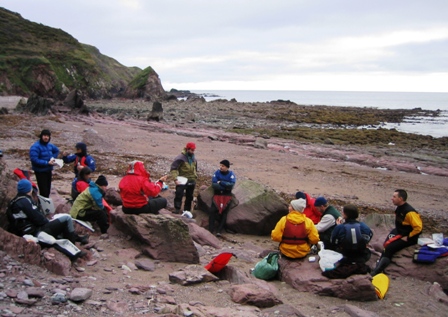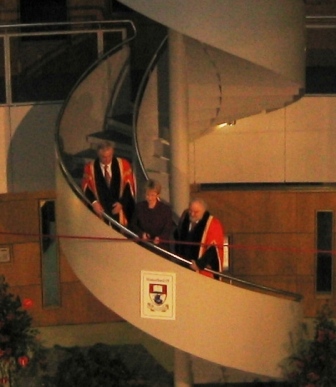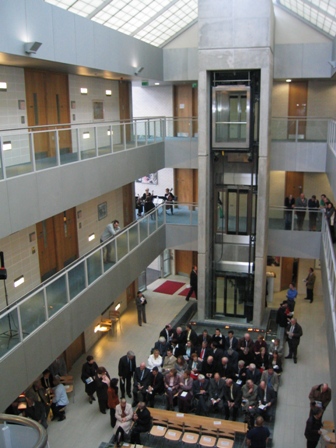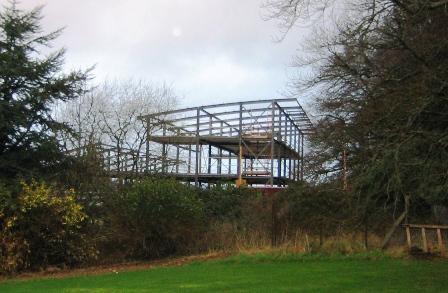30 January 2005
Metadata - friend of foe?
Bill de hモra argues that it is time to stop complaining about metadata and start using it. I agree, but note that all the success stories he notes use clever forms of social engineering to make it worthwhile creating the metadata in the first place. Cory's famous rant against metacrap was arguing against heavily engineered central systems that just assumed some poor smuck would create the metadata needed, and of course no one ever did. Typical of this type of system are those imposed by managers on employees for "tracking" without analysis of the overhead of using the system. Anyone who has used an inflexible problem logging system will know what I mean.
29 January 2005
Helvick Head Outing

On Saturday morning I went with a group of sea kayakers on a trip from Helvick Head in Co. Waterford towards Ardmore (though not all the way). The trip was organised by Paul Durnan, the key contact in the South East Sea Kayaking group. Details of these trips are published on the Irish Sea Kayakers Association ISKA Bulletin Board. Note the strange URL for the site, though the more sensible ISKA redirects you to it.
Whilst it was quite chilly, it was great to be out on the water in January. There were fourteen of us in all, though Des Keaney, from Deep Blue Sea Kayaking stayed onshore, and provided a lift back from the halfway point for anyone not feeling up to the return trip. All in all it was a great day, lasting from 10:00am to 18:00pm, followed by a sociable drink for those still able to move their arms. The photo above shows the lunch stop at a beach near Ardmore.
28 January 2005
Minister Opens WIT Information Technology Building


On Friday 28th January 2005 Minister for Education Mary Hannifan opened WIT's new Information Technology building. This shot captures the Minister cutting a ribbon to symbolically open the building.
24 January 2005
EU Says Bureaucracy Hurting IT Research Efforts
ComputerWeekly notes EU Says Bureaucracy Hurting IT Research Efforts, Competitiveness
"The panel said the research was vital for competitiveness but that it more investment and less bureaucracy are required for success.The panel was chaired by former Portuguese science minister Jose Mariano Gago, who was one of the authors of the European Commission's 10-year Lisbon Strategy, which aims to make the EU the "world's most dynamic and competitive economy."
Viviane Reding, European Commission information society and media commissioner, said, "Fast-changing IST research is, and must remain, a key driver for the rapid economy-wide technological innovation on which Europe's skilled jobs ultimately depend."
23 January 2005
Top Five Home Networking Annoyances
Kathy Ivens posted this article O'Reilly Network: Top Five Home Networking Annoyances on the O'Reilly Network site. It summarises the key problems faced by people with home networks using Microsoft OS machines, and the some simple solutions to these problems.
Reviewing W3C Architecture
Harry Halpin has just published an article XML.com: Reviewing the Architecture of the World Wide Web on O'Reilly's XML.com site.
It is strange that the formal architecture document, AWWW (Architecture of the World Wide Web) released in December 2004, authored by the TAG (Technical Advisory Group of the W3C) has come 10 years after the event, so to speak. This is becuase the web arose from a series of specific specifications (i.e. definition of a url, http, and html) rather than an overall architecture. The best practice has grown, to some extent organically, around the core.
This article puts the AWWW in context and summarises its key points, and is thus very useful.
21 January 2005
Waterford MAN - e-net take over management
Last Wed evening I went with a number of TSSG colleagues to a meeting about Waterford's MAN (Metropolitan Area Network). The official launch of the network itself was last September: Waterford MAN launch.
This is an OAN (Open Access Network) owned by the public body (in this case Waterford Corporation), but leased out to competing operators. Where e-net come into it is as the neutral administrators of this network. It is part of regional and national network of such MANs. Service providers can pay standard rates to e-net to get rackspace in the co-location facility in each city/town. This then means that businesses connected can buy services from any of the service providers who have set up like this. The idea is that this reduces the infrastructural investment costs that each service provider has to put up before being able to start offering broadband to customers.
The TSSG has been instrumental in laying the groundwork for these developments. Willie Donnelly, the Director of the TSSG, co-founded the SEISS (South East Information Society Strategy) initiative. The original SERPANT proposal, coming from SEISS, for funding from the Irish Department of Communications, the Marine and Natutal Resources (DCMNR) is what led to the investment in the regional WANs in the South East of Ireland: Clonmel, Dungarvan, Carlow, Kilkenny, Wexford and Waterford.
As yet this the MAN service is primarily targetted at business and large public sector customers, rather than individual end users, but with new wireless standards with wide area coverage we could see the MANs being used as a core network for a much wider service offering to consumers.
I have been very interested in the concept of open access networks for a few years now, both in terms of core optical networks, and in terms of wireless access networks. I have been very impressed by KTH (Technical Unioversity of Stockholm) and their involvment in Stockholm Open. This currently allows multiple operators to share both a core optical network and a WiFi access network in Stockhom and its suburbs (such as Kista where KTH and Ericsson are based). I hope that the MANs can deviver a pan-Irish open access network based on on these same principles.
NetKernel
This product looks like a great innovative way of experimenting with lightweight services: NetKernel
Version 2.0.2 has now been released, though this Jon Udell posting refers to an earlier version:
The 1060 REST microkernel and XML app server (Thursday, February 26, 2004).
20 January 2005
TSSG's Research Building Progress

The TSSG won funding from Ireland's Higher Education Authority HEA PRTLI for a research programme called M-Zones (in partnershop with TCD and CIT) and part of this was to fund a research building in WIT. This funding has been combined with Enterprise Ireland funding for an incubation centre for new business to create WIT's Research and Innovation Building. The building is due to open in September 2005, and is progressing well as the photo demonstrates. The building is located in WIT's new Carraiganore site, on the banks of the river Suir.
7 January 2005
Media History
Here's a movie presenting a plausable history of media consolidation written from a 2014 perspective: EPIC (ols-master). Very interesting. Thanks to Shane Dempsey for the link :-)